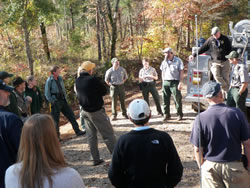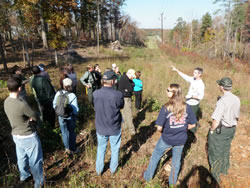
National Fire Plan Success Story
NPS Southeast Region Conducts Second Annual Fire Interpretation Workshop
Kings Mountain National Military Park, South Carolina
National Fire Plan - Accountability
2010

Kings Mountain engine operator Alex Scronce (center, in ballcap) explains fire operations during the field trip. Great Smoky Mountains Wildland Fire Module leader Dave Loveland stands on the engine at the right side of the photo; in front of Dave, also in uniform, stands Kings Mountain Fire Management Officer and Chief Ranger Chris Revels.

Great Smoky Mountains fire ecologist Rob Klein points out the difference between meadow species and an overgrown hardwood forest to workshop participants during the field day at Kings Mountain National Military Park.
On October 28 and 29, 2009, thirty interpreters, public affairs officers, and fire practitioners gathered at Kings Mountain National Military Park to exchange success stories, insights, and inspirations about how the National Park Service talks about fire. The Second Annual Southeast Regional Fire Interpretation Workshop combined a day of classroom discussion with a firsthand look at fire operations and fire effects at Kings Mountain.
As one public affairs officer put it, “It was excellent to hear from the seasoned employees as well as from the newer ones.” Ranging from volunteers to park superintendents, employees from eight states and Puerto Rico, met to hear descriptions of fire interpretation programs at large icon parks, such as the Everglades, as well as “how to” talks about developing very simple, low-cost, high-interest visitor programs about fire that a single park ranger could easily deliver at Natchez Trace Parkway. Participants also heard specific ideas for other units in between, including Mammoth Cave National Park and Horseshoe Bend National Military Park.
“The field studies provided a relaxed and great opportunity to network,” commented an observer from the U.S. Forest Service. The field day gave Kings Mountain staff, led by Chief Ranger and Fire Management Officer Chris Revels, a chance to show off the extensive work they have done since 2001 using fire to restore a cultural landscape. In cooperation with the Great Smoky Mountains Wildland Fire Module, Revels and his staff have been using prescribed fire to recreate the landscape of 1780. Workshop participants had the opportunity to observe the fire crew burning piles of brush and slash. Staff from the Great Smoky Mountains Fire Effects Module demonstrated fire effects monitoring techniques and explained the beneficial effects of prescribed fire on the piedmont ecosystem. As one brand-new seasonal interpretive ranger put it, “Seeing the contrast of areas overgrown with brush versus areas open with diverse flora growing makes talking about the need for fire much easier than in a visitor center.”
This example of interdisciplinary communication about the National Park Service mission was further showcased at the National Association for Interpretation National Workshop held in Hartford, Connecticut, November 16-21, 2009, for an interagency audience of interpreters from across the United States.
Contact: Rudy Evenson, Fire Communication and Education Specialist, (404) 507-5628.